Uncover the Hidden Gems of Tartu: Things to Do
Tartu, nestled in the heart of Estonia, is a lively city that exudes charm and historical depth. Renowned as a cultural hub, it boasts a diverse array of arts and cultural projects that breathe life into its streets. With its picturesque architecture, bustling galleries, and vibrant festivals, Tartu invites visitors to immerse themselves in the rich artistic heritage of Estonia. This city not only showcases its historical significance but also serves as a canvas for contemporary creativity, making it an essential destination for anyone eager to discover and experience the essence of Estonian culture.
Tartu in Estonia
The city’s reputation as a University City adds an energetic and youthful atmosphere. The presence of the university enriches Tartu’s cultural tapestry, offering visitors a unique blend of historical and modern experiences. Exploring Tartu’s combination of vibrant arts, intellectual buzz, and picturesque streets reveals a charming city full of surprises.
From visiting historic sites to strolling along the Emajogi River, Tartu offers activities for all types of travelers. Whether interested in museums, architecture, or simply enjoying the lively local culture, Tartu promises an enriching journey.
Historic Landmarks and Architecture
Tartu is rich in historical landmarks and remarkable architecture. Visitors can explore the ancient Cathedral Ruins on Toome Hill, admire the vibrant Old Town with its enchanting Raekoja Plats, and discover the elegance of Tartu Town Hall. In addition, the magnificent St. John’s Church displays exquisite medieval craftsmanship.
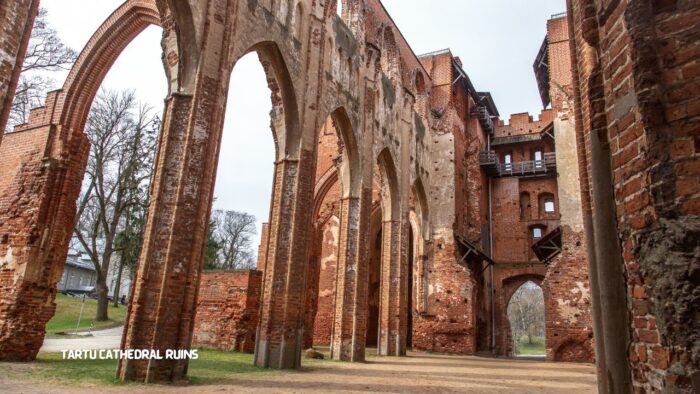
Toome Hill and Cathedral Ruins
Toome Hill is a significant site in Tartu, offering a mix of natural beauty and historical intrigue. The Tartu Cathedral ruins, perched atop the hill, are among the most striking landmarks. Dating back to the 13th century, these ruins are a testament to medieval Gothic architecture.
Once a majestic structure, the cathedral now offers views of its ancient walls and arches. Visitors are free to explore the grounds and enjoy the lush surroundings. The hill also houses the University of Tartu Museum, where more about the site’s history can be learned. Toome Hill is an engaging spot for history buffs and nature enthusiasts alike.
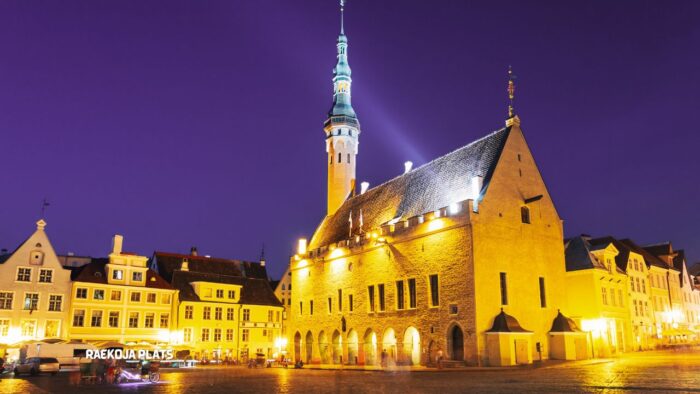
Old Town and Raekoja Plats
The Old Town in Tartu is a treasure trove of history, characterized by its quaint cobblestone streets and vibrant atmosphere. At the heart of this area lies Raekoja Plats, a lively square surrounded by colorful historic buildings.
Raekoja Plats is often bustling with activities, from markets to cultural events, making it a focal point for locals and tourists. The architecture here tells a story of the town’s rich past, with each building displaying unique designs. Visitors can enjoy a peaceful stroll, soak in the cultural richness, and perhaps stop by a café for a taste of local delicacies.
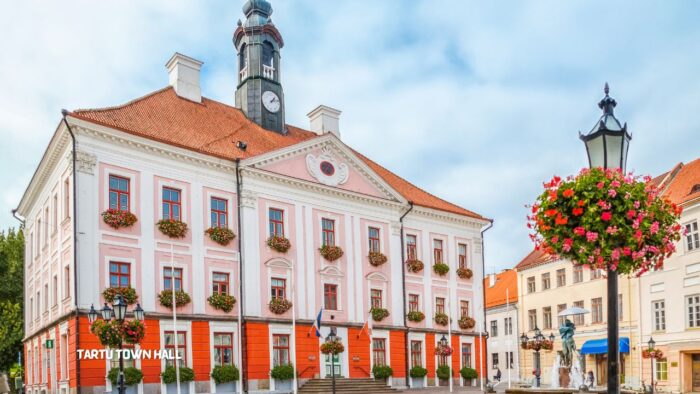
Tartu Town Hall and Raekoja Square
Tartu Town Hall stands proudly in Raekoja Square, showcasing classic baroque architecture. Constructed in the 18th century, the Town Hall serves as a symbol of civic pride and historical significance.
The building’s façade is adorned with intricate details, and the carillon, which chimes hourly, adds to its charm. Inside, the Town Hall houses various municipal offices and a ceremonial hall that hosts official events. Visitors can admire the building from Raekoja Square, a place that frequently hosts public gatherings and seasonal festivities, making it a lively hub in Tartu.
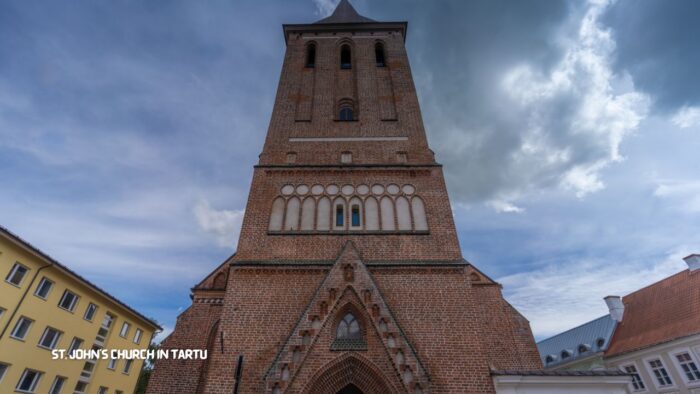
St. John’s Church
St. John’s Church is a masterpiece of medieval architecture, known for its terracotta sculptures. Dating back to the 14th century, the church stands as one of the oldest buildings in Tartu.
Its unique red brick design and vast collection of medieval sculptures inside are of significant artistic and historical value. Visitors can attend services or simply admire the intricate details and serene atmosphere within its walls. The church remains an important religious and cultural monument, providing insight into the city’s spiritual heritage and architectural grandeur.
Cultural Exploration
Immerse yourself in the rich cultural landscape of Tartu, where the storied halls of its historic university resonate with centuries of knowledge and discovery. Explore the captivating array of museums that showcase Estonia’s diverse heritage, from ancient artifacts to contemporary art, each offering a window into the nation’s past and present. Stroll through the city’s vibrant creative spaces, where innovation and artistic expression come to life, inviting you to experience the dynamic spirit of Tartu and its contributions to Estonian culture.
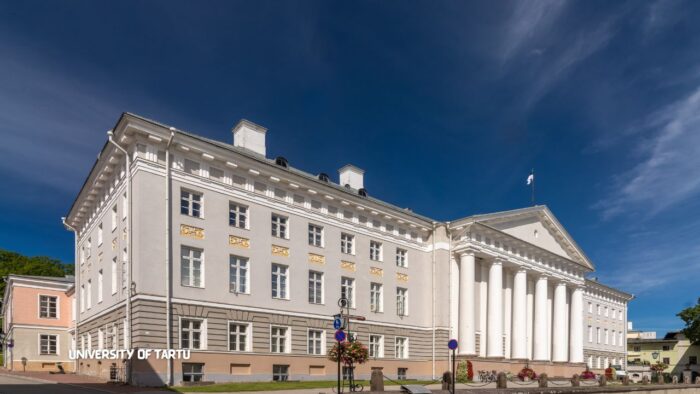
University of Tartu
The University of Tartu is a central part of Estonian higher education. Established in 1632, the campus mixes old architecture with modern facilities. Visitors can explore its historic buildings, like the main building, admired for its neoclassical design. The university’s library holds rare books and manuscripts that reflect Estonia’s academic history. Public lectures and workshops are often available, inviting guests to engage with cutting-edge research. The university campus also features picturesque parks where visitors can stroll and enjoy the tranquil atmosphere, making it an ideal spot for both learning and relaxation.
Estonian National Museum
The Estonian National Museum is a focal point for understanding the nation’s cultural heritage. Located in a modern building, the museum showcases exhibits on Estonian history, folklore, and ethnicity. Displays range from traditional clothing to interactive technology, offering diverse insights into Estonian life. Special exhibits often highlight unique aspects of the region’s culture, such as language and celebrations. The museum grounds house outdoor exhibits and sculptures, making it a comprehensive cultural experience. Visitors can also enjoy educational programs and workshops that delve deeper into the themes on display and provide a deeper understanding of the cultural narratives.
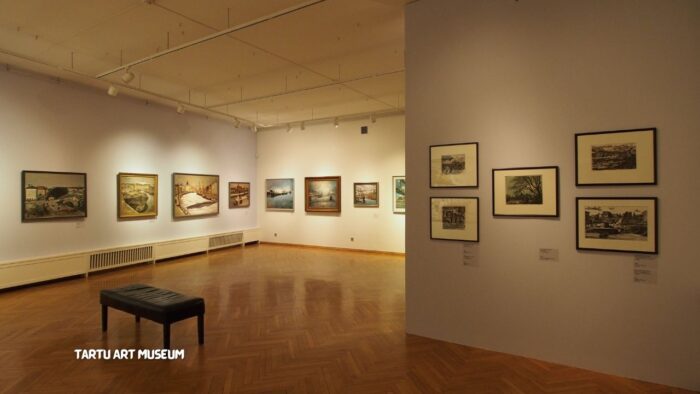
Tartu Art Museum
The Tartu Art Museum captures the essence of Estonian visual arts. Situated in a characteristic leaning building, this museum holds a wide collection of works, from classic to contemporary. It features pieces by notable Estonian artists and rotating exhibitions that highlight innovative art trends. Educational programs and guided tours are available, offering insights into the art pieces and their creators. The museum also hosts events like art workshops and discussions to engage audiences with the artistic process. This is a go-to spot for those interested in exploring Estonian creativity through various artistic expressions.
Typa
Typa is a unique cultural hub dedicated to print and paper art. This creative space hosts a variety of workshops and exhibitions focused on traditional printing techniques and contemporary paper-making. Visitors can try their hand at crafting paper or printing and learn about the art through interactive demonstrations. Typa also offers guided tours that explore the history and machinery involved in these crafts. The inviting atmosphere encourages creativity, providing a hand-on cultural experience for visitors of all ages. With its commitment to preserving traditional techniques, Typa stands out as an inspiring site for appreciating the tactile forms of art.
Aparaaditehas
The Aparaaditehas is a vibrant cultural factory, recognized for its artistic vibe. Housed in a former factory building, it features studios, galleries, and workshops that span multiple artistic disciplines. The venue hosts events like festivals, markets, and performances, fostering a lively community spirit. Visitors can explore the creative studios or attend art exhibitions that showcase local talents. It’s also a great place for food enthusiasts, as it houses eclectic cafes and eateries. The innovative environment of Aparaaditehas offers a unique blend of art, design, and culinary delights, making it a must-visit for those interested in modern cultural dynamics.
Natural Attractions
Tartu offers an amazing blend of natural beauty with spots that highlight both serene landscapes and vibrant ecosystems. Visitors can enjoy a stroll through lush gardens, explore river paths, or relax by a tranquil lake.
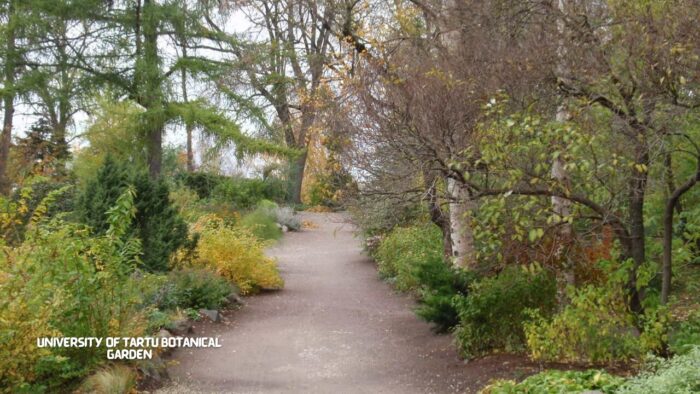
Botanical Gardens
The Tartu Botanical Gardens is a lovely space with a rich collection of exotic and native plants. Located near the city center, it showcases diverse flora across well-maintained paths and greenhouses. Visitors can explore themed areas featuring different plant species, including tropical collections and native Estonian plants. There’s also a peaceful pond area surrounded by vibrant plant life and comfortable seating. It’s an ideal spot for those interested in botany or simply wishing to relax in a beautiful setting. With educational plaques, the gardens are both a learning area and a place of tranquility.
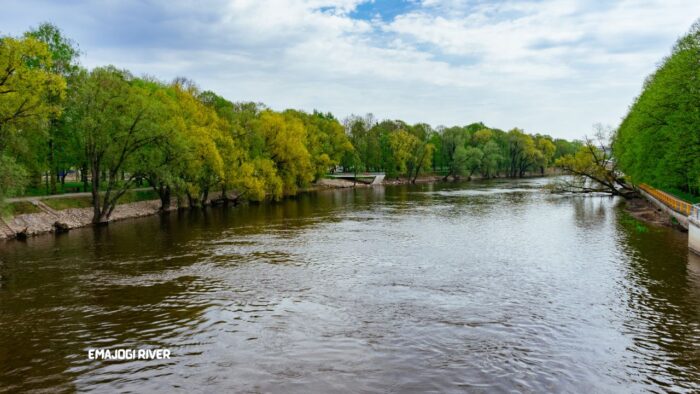
Emajogi River
The Emajogi River flows elegantly through Tartu, offering a scenic spot for leisure activities. Its banks are lined with paths perfect for walking and cycling, with views that include passing boats and lush greenery. The river is a key feature of Tartu’s landscape, connecting the city to Lake Peipsi. Visitors can take part in river cruises or kayaking adventures to experience the waterway up close. The river area is also good for birdwatching, with many species frequenting its banks. Various parks nearby make for excellent picnic spots, where one can enjoy the sounds of flowing water and diverse wildlife.
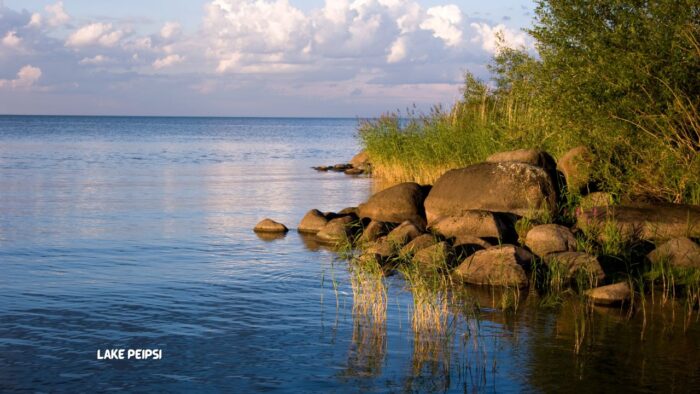
Lake Peipsi
Lake Peipsi is one of the largest lakes in Europe, located east of Tartu. It serves as a stunning natural boundary between Estonia and Russia. The lake is famous for its clear waters and sandy shores, making it a perfect destination for swimming and sunbathing in warmer months. Fishing is also popular here, with the lake housing a variety of fish species. The surrounding areas are rich in cultural history, with traditional villages and scenic landscapes. Nature enthusiasts can enjoy hiking trails around the lake, taking in views of rolling hills and picturesque fields.
Leisure and Recreation
Tartu, Estonia, is a treasure trove of leisure and recreational delights, inviting visitors to immerse themselves in its rich tapestry of experiences. Strolling through the enchanting neighborhoods of Supilinn and Karlova, one can admire the quaint wooden houses, vibrant street art, and lush greenery that breathe life into the atmosphere. Each corner reveals its own charm, echoing the city’s historical essence and contemporary spirit.
For those eager to delve deeper into the local culture, the Onion Route offers a fascinating journey through the region’s agricultural heritage and culinary traditions. This vibrant path not only showcases the unique flavors of the local cuisine but also connects travelers with the warm and welcoming nature of the community. Engaging with local customs and people enhances the experience, providing a vivid insight into Tartu’s cultural fabric. Whether wandering through its picturesque streets or exploring cultural landmarks, Tartu promises an unforgettable adventure filled with discovery and connection.
Supilinn (Soup Town)
Supilinn, also known as Soup Town, is a neighborhood famous for its unique character and history. It’s a place where visitors can enjoy leisurely walks through streets named after vegetables. This quirky naming is a nod to its past as a working-class area where gardens thrived.
Supilinn’s wooden houses and colorful facades give the neighborhood a distinctive charm. The area also hosts small cafes and playgrounds, making it a fun spot for families. Those visiting in the spring can admire the blooms, adding to the neighborhood’s vibrant atmosphere. An excursion here offers a glimpse into local life and a chance to enjoy Tartu’s more laid-back side.
Karlova Neighbourhood
The Karlova Neighbourhood is a hub for artists and creatives. Known for its wooden architecture and bohemian flair, Karlova is a cultural hotspot. It’s an ideal place for those interested in arts and community life. Visitors can stroll down streets lined with art galleries, vintage shops, and cafes, including the popular Karlova Kohv, which offers a cozy spot for coffee and local pastries.
Karlova is also a venue for various festivals and community events throughout the year. These events bring together locals and visitors in a spirited celebration of culture and creativity. Walking through Karlova provides a sense of its vibrant community and eclectic spirit.
Onion Route
The Onion Route is a fascinating journey through diverse culture and history. This route takes travelers through traditional Estonian villages renowned for their onion farming. Along the way, visitors can explore local museums, farmsteads, and craft shops that showcase the region’s unique traditions and produce.
The route highlights the cultural blend of Estonian and Russian influences that define the area. Travelers can enjoy local dishes made with the route’s famed onion, offering a culinary experience like no other. The Onion Route provides a rich cultural exploration of Tartu’s surrounding countryside.
How to Get to Tartu, Estonia
Traveling to Tartu, Estonia, is straightforward and offers several modes of transport.
By Air
The nearest major airport is Lennart Meri Tallinn Airport (TLL). From there, travelers can take a bus or train to reach Tartu. Some regional airports in Europe might have seasonal flights directly to Tartu Airport, but they are less frequent.
By Train
Trains run regularly between Tallinn and Tartu. The journey takes about two hours and offers a comfortable ride. The Elron train website provides schedules and ticket information.
By Bus
Buses are another convenient option. They depart frequently from Tallinn and other major Estonian cities. The ride is approximately 2.5 to 3 hours. Lux Express and Ecolines are two major companies operating on these routes.
By Car
Driving to Tartu gives the flexibility to explore at one’s own pace. The drive from Tallinn is a 2-3 hour journey along well-maintained roads.
It’s easy to navigate to Tartu regardless of the chosen method. Each option offers its own advantages, ensuring travelers can find a method that suits their needs.
Events and Festivals
Tartu, a vibrant cultural hub in the Baltic States, is renowned for its lively events and festivals. Throughout the year, the city hosts a variety of celebrations that highlight its rich heritage and dynamic arts scene.
One of the major events is the Simple Session, held annually in August. This international festival draws BMX and skateboarding enthusiasts worldwide to the historic Comb Factory district. Each year, it offers thrilling competitions and showcases urban culture.
Another must-see event is the Tartu Hanseatic Days, a summer festival celebrating Tartu’s historical connections. The city comes alive with medieval markets, street performances, and traditional crafts, offering a glimpse into its past.
In winter, Tartu hosts the Christmas City Festival. The beautiful Town Hall Square transforms into a festive wonderland with twinkling lights, seasonal stalls, and ice skating. Visitors can enjoy local treats and shop for unique gifts.
For art lovers, the Tartu Love Film Festival showcases romantic films, drawing cinephiles from near and far. It’s a celebration of stories that warm the heart amidst the cold Baltic winter.
Tartu is also known for its academic connections, which shine during the Student Days Festival. This vibrant event features concerts, workshops, and student competitions, reflecting the youthful spirit of the city.
These events provide a wonderful way to experience the unique blend of tradition and modernity that defines Tartu’s cultural landscape.
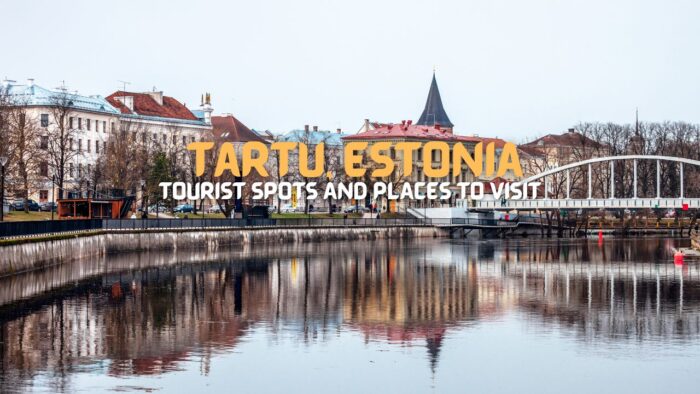
Frequently Asked Questions
What are the best indoor activities to experience in Tartu during winter?
Tartu offers a variety of engaging indoor activities perfect for winter. You can explore the fascinating exhibits at the Science Centre AHHAA, which is great for all ages. The Estonian National Museum provides a deep dive into the country’s history and culture. For a more unique experience, visit Typa, a center dedicated to printing and paper art. Families will enjoy the Tartu Toy Museum, which showcases toys from different eras. Additionally, the University of Tartu Museum offers intriguing insights into the academic history of this prestigious institution.
Which attractions can visitors explore for free in Tartu?
Visitors to Tartu can explore several attractions for free, making for an enriching yet budget-friendly experience. The University of Tartu offers a picturesque campus with historic buildings and beautiful grounds. Art enthusiasts can enjoy free exhibitions at venues like the Tartu Art House, TYPA Gallery, and the Guild Gallery, providing a diverse array of local and contemporary art. Additionally, the scenic Toomemägi Hill, home to ancient castle ruins and a bell tower, offers stunning views of the city (source). Lastly, visitors can take a leisurely stroll along the Emajõgi River, enjoying the natural beauty and tranquil atmosphere of Tartu.
What are the top family-friendly activities in Tartu?
Tartu offers a variety of family-friendly activities that cater to all ages. The Science Centre AHHAA is a must-visit, with its interactive exhibits and hands-on experiments that captivate both children and adults. The Tartu Toy Museum provides a nostalgic journey through the history of toys, featuring play areas and workshops. Nature lovers will enjoy the University of Tartu Botanical Garden, which offers a serene environment to explore diverse plant species. For a unique experience, families can visit the Upside Down House, where everything is literally turned upside down, providing a fun and disorienting adventure. Finally, the Aura Water Centre is perfect for those looking to relax and have fun, featuring pools, slides, and a spa area.
How many days are recommended to fully experience Tartu?
To fully experience Tartu, it is recommended to spend at least two to three days in the city. This timeframe allows visitors to explore the main attractions such as the Science Centre AHHAA, the Estonian National Museum, and the charming Tartu Old Town. Additionally, you can take your time to enjoy the University of Tartu Botanical Garden and the scenic Toomemägi Hill. Spending a few days also provides the opportunity to experience local cafes, restaurants, and the vibrant cultural scene, ensuring a well-rounded visit to Estonia’s second-largest city.
Why is Tartu a significant destination for travelers?
Tartu is a significant destination for travelers due to its rich cultural heritage, vibrant academic atmosphere, and engaging attractions. As Estonia’s second-largest city and home to one of Northern Europe’s oldest universities, Tartu exudes an intellectual charm that draws visitors interested in history and education. The city is celebrated for its lively arts scene, highlighted by its designation as a European Capital of Culture for 2024, which promises a year-long celebration of Estonian heritage and artistic expression. Additionally, Tartu offers a plethora of museums, such as the Estonian National Museum and the Tartu Toy Museum, which cater to diverse interests. The city’s compact size makes it easy to explore on foot, allowing travelers to enjoy its picturesque old town, beautiful parks, and the serene Emajõgi River. With a blend of historical significance and modern vibrancy, Tartu provides a unique and enriching travel experience.
What are the must-see historical landmarks in Tartu’s Old Town?
Tartu’s Old Town is rich with historical landmarks that are must-sees for any visitor. The Tartu Town Hall Square is the heart of the city, featuring the iconic Town Hall building and the charming “Kissing Students” fountain. Nearby, the University of Tartu, founded in 1632, stands as a testament to the city’s long academic tradition, with its main building and surrounding campus offering a glimpse into its storied past. The Leaning House, a historical curiosity due to its noticeable tilt, is another intriguing site. Additionally, the ruins of the Tartu Cathedral, located on Toome Hill, provide a fascinating look into medieval architecture and history. These landmarks collectively showcase Tartu’s rich heritage and make the Old Town a captivating area to explore.
Tartu Travel and Tour Packages
Like, Follow, and Subscribe to OutofTownBlog.com on Facebook, Twitter, Instagram, and Team out Of Town on YouTube for more Tartu Tourist Spots.
Read:
